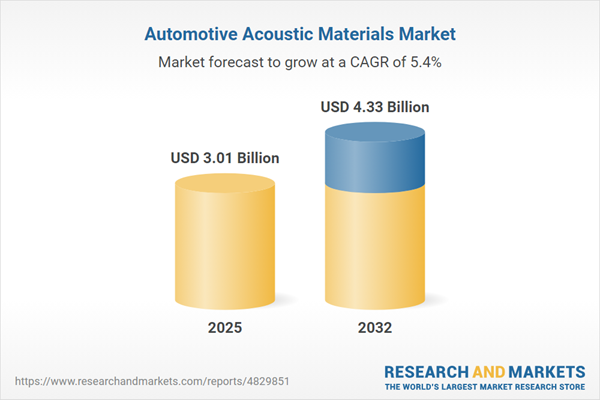Speak directly to the analyst to clarify any post sales queries you may have.
The automotive acoustic materials market is undergoing robust transformation, as technological advances and shifting industry mandates drive demand for high-performance, sustainable solutions across diverse vehicle segments worldwide.
Market Snapshot: Automotive Acoustic Materials Growth Trajectory
The Automotive Acoustic Materials Market grew from USD 2.85 billion in 2024 to USD 3.01 billion in 2025. It is expected to continue growing at a CAGR of 5.35%, reaching USD 4.33 billion by 2032. This high-value growth underscores rising OEM and aftermarket investments in advanced, lightweight noise reduction systems tailored to evolving mobility platforms and regulatory landscapes.
Scope & Segmentation
- Application Areas: Cabin noise reduction, engine bay noise control, exhaust system noise control, undercarriage noise control
- Material Types: • Fibers (glass, natural, polyester) • Foams (melamine, polyethylene, polyurethane) • Rubbers (butyl, EPDM) • Textiles / nonwoven fabrics • Thermoplastic polymers (polypropylene, polyvinyl chloride)
- Vehicle Types: • Commercial vehicles (heavy, light) • Electric vehicles (battery, hybrid) • Passenger cars (compact, luxury, mid-size)
- End Users: Aftermarket customers, original equipment manufacturers
- Distribution Channels: Offline and online platforms for sales and retrofitting
- Geographic Regions: • Americas (including North and Latin America) • Europe, Middle East, and Africa (incorporating Western, Eastern Europe and EMEA) • Asia-Pacific (including China, India, Japan, Australia, South Korea, Southeast Asia)
- Featured Companies: Freudenberg Performance Materials SE & Co. KG, Autoneum Holding AG, 3M Company, BASF SE, Dow Inc., Armacell International S.A., Johns Manville International Inc., Trelleborg AB, Forvia SA, Henkel AG & Co. KGaA
Key Takeaways
- The automotive acoustic materials market is shifting from traditional insulation to sophisticated multi-layered systems, aimed at meeting stringent noise, vibration, and harshness (NVH) requirements across all vehicle zones.
- Electrification and lightweighting have redefined acoustic challenges, leading to the adoption of composite structures and digital modeling tools to achieve sound attenuation and mass reduction.
- Increasing regulatory and consumer expectations around interior sound quality have made acoustic optimization a key differentiator for OEMs and launch campaigns, especially in electric and hybrid vehicle markets.
- Collaboration among OEMs, suppliers, and material scientists is producing tailored solutions aligned with vehicle architecture and usage, further accelerated by advances in rapid prototyping and acoustic simulation platforms.
- Sustainability concerns and tariff shifts have triggered a move towards domestic manufacturing, alternative materials, and enhanced supply chain mapping to support resilience and compliance.
- Distribution strategies differentiate between OEM integration needs and functional aftermarket solutions, leading to comprehensive product portfolios and diverse channel engagement.
Tariff Impact
The introduction of new United States tariffs on imported acoustic materials in 2025 has led to significant supply chain recalibration in North America. Manufacturers are accelerating production localization, exploring tariff-free alternatives, and collaborating closely with domestic suppliers. These adjustments foster greater agility and support compliance with government incentives, ultimately encouraging innovation in both materials and processes while minimizing cost volatility.
Methodology & Data Sources
This assessment applies a rigorous, blended-methodology approach. Initial phases involved secondary research across academic, regulatory, and industry resources. In-depth interviews with OEM executives, R&D leads, and procurement managers provided current insights, while data triangulation and workshops ensured validation through expert consensus and market modeling. Regional analysis accounted for trade, supply chain, and innovation trends shaping segment performance.
Why This Report Matters
- Understand the drivers behind evolving material innovation, enabling data-driven investment and R&D decisions in acoustic technology.
- Mitigate supply chain risks by recognizing tariff impacts, localization opportunities, and diversification pathways for long-term strategic value.
- Align product, sourcing, and customer engagement strategies with the latest trends in lightweighting, sustainability, and digital manufacturing relevant to the automotive acoustic materials sector.
Conclusion
The automotive acoustic materials landscape is defined by rapid innovation, regulatory adaptation, and the convergence of mobility megatrends. Strategic collaboration, technology leadership, and resilient supply chains will be central to sustained market advantage as global mobility evolves.
Additional Product Information:
- Purchase of this report includes 1 year online access with quarterly updates.
- This report can be updated on request. Please contact our Customer Experience team using the Ask a Question widget on our website.
Table of Contents
3. Executive Summary
4. Market Overview
7. Cumulative Impact of Artificial Intelligence 2025
Companies Mentioned
The companies profiled in this Automotive Acoustic Materials market report include:- Freudenberg Performance Materials SE & Co. KG
- Autoneum Holding AG
- 3M Company
- BASF SE
- Dow Inc.
- Armacell International S.A.
- Johns Manville International Inc.
- Trelleborg AB
- Forvia SA
- Henkel AG & Co. KGaA
Table Information
| Report Attribute | Details |
|---|---|
| No. of Pages | 181 |
| Published | October 2025 |
| Forecast Period | 2025 - 2032 |
| Estimated Market Value ( USD | $ 3.01 Billion |
| Forecasted Market Value ( USD | $ 4.33 Billion |
| Compound Annual Growth Rate | 5.3% |
| Regions Covered | Global |
| No. of Companies Mentioned | 11 |









